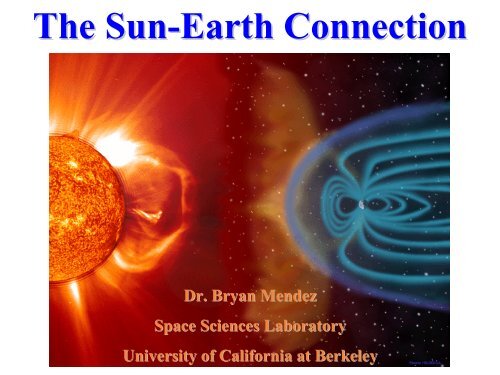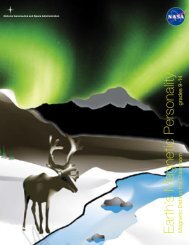The Sun-Earth Connection
The Sun-Earth Connection
The Sun-Earth Connection
You also want an ePaper? Increase the reach of your titles
YUMPU automatically turns print PDFs into web optimized ePapers that Google loves.
<strong>The</strong> <strong>Sun</strong>-<strong>Earth</strong> <strong>Sun</strong> <strong>Earth</strong> <strong>Connection</strong><br />
Dr. Bryan Mendez<br />
Space Sciences Laboratory<br />
University of California at Berkeley
<strong>The</strong><br />
<strong>Sun</strong>
What is the <strong>Sun</strong>?<br />
Radius 696,000 km (109 times <strong>Earth</strong>’s radius)<br />
Rotation Rate 27 days (equator) to 31 days (poles)<br />
Luminosity<br />
(Power Output)<br />
Surface Temperature 5,800 K (average)<br />
<strong>The</strong> <strong>Sun</strong> is a Star, but seen<br />
close-up.<br />
<strong>The</strong> Stars are other <strong>Sun</strong>s but<br />
very far away.<br />
3.8 x 10 26 watts (10 trillion times the power<br />
consumption of all <strong>Earth</strong>’s nations combined)<br />
Mass 2 x 10 30 kg (300,000 times <strong>Earth</strong>’s mass)<br />
Composition 70% Hydrogen, 28% Helium, 2% heavier elements<br />
(by percentage of mass)<br />
Age 5 billion years (expected to live another 5 billion)<br />
<strong>The</strong> <strong>Sun</strong> is giant ball of<br />
very hot, mostly ionized<br />
gas that shines under its<br />
own power.
Size and Distance of the <strong>Sun</strong><br />
• <strong>The</strong> <strong>Sun</strong> is 109 times the<br />
diameter of <strong>Earth</strong><br />
(10 times the diameter of<br />
Jupiter).<br />
• Over 1,000,000 <strong>Earth</strong>s <strong>Sun</strong><br />
could fit inside the <strong>Sun</strong>.<br />
• <strong>The</strong> <strong>Sun</strong> is 150 million<br />
kilometers away from<br />
<strong>Earth</strong><br />
<strong>Earth</strong>. 390 times farther<br />
away than the Moon.<br />
• It takes light 8 minutes to<br />
Moon<br />
travel to <strong>Earth</strong> from the<br />
<strong>Sun</strong>.<br />
• This distance is defined as<br />
1 Astronomical Unit (AU)
<strong>The</strong> Different Parts of the <strong>Sun</strong><br />
Core<br />
• Nuclear Fusion H → He<br />
• T = 15,000,000 K<br />
Radiative Zone<br />
• Energy transported by light<br />
• T = 10,000,000 K<br />
Convective Zone<br />
• Energy transported by convection<br />
Photosphere<br />
• Visible surface<br />
• Far less dense than <strong>Earth</strong>’s atmosphere<br />
• T = 5,800 K<br />
• <strong>Sun</strong>spots: T = 4,000 K<br />
Chromosphere<br />
• Thin layer above photosphere<br />
• Produces most of <strong>Sun</strong>’s UV light<br />
• T = 10,000 K<br />
Corona<br />
• Tenuous, extends out millions of kilometers<br />
• Emits X-rays<br />
• T = 1,000,000 K
<strong>The</strong> Different Parts of the <strong>Sun</strong><br />
Looking at the <strong>Sun</strong> in<br />
different wavelengths of<br />
light reveals different<br />
parts of the <strong>Sun</strong>.<br />
Visible light (white light):<br />
Wavelength = 400-700 nm<br />
See radiation from <strong>Sun</strong>’s<br />
“surface”, Photosphere
<strong>The</strong> Different Parts of the <strong>Sun</strong><br />
Looking at the <strong>Sun</strong> in<br />
different wavelengths of<br />
light reveals different<br />
parts of the <strong>Sun</strong>.<br />
Visible light (H-α):<br />
Wavelength = 656.3 nm<br />
See radiation from layer<br />
just above <strong>Sun</strong>’s surface,<br />
Chromosphere
<strong>The</strong> Different Parts of the <strong>Sun</strong><br />
Looking at the <strong>Sun</strong> in<br />
different wavelengths of<br />
light reveals different<br />
parts of the <strong>Sun</strong>.<br />
Extreme Ultraviolet light:<br />
Wavelength = 17.1 nm<br />
See radiation from <strong>Sun</strong>’s<br />
atmosphere, Corona<br />
Image from STEREO mission
<strong>The</strong> Different Parts of the <strong>Sun</strong><br />
During a total eclipse of the <strong>Sun</strong>, the<br />
very bright Photosphere is blocked and<br />
the <strong>Sun</strong>’s outer atmosphere becomes<br />
visible (in white light). We call it the<br />
Corona<br />
Spacecraft, like SOHO and STEREO,<br />
place a disk in front of their cameras to<br />
create an eclipse. <strong>The</strong>y are then able to<br />
take images with a larger view of the<br />
<strong>Sun</strong>’s Corona<br />
It extends far out into the Solar System,<br />
in fact we live in it!
<strong>The</strong> Solar Wind<br />
<strong>The</strong> solar wind is a stream of mostly charged<br />
particles that emanate from the <strong>Sun</strong> and blow<br />
throughout the Solar System.<br />
It blows a bubble in the interstellar medium about<br />
200 AU in diameter. <strong>The</strong> space inside this bubble<br />
is called the Heliosphere.<br />
<strong>The</strong> shape of <strong>Earth</strong>’s<br />
magnetosphere is distorted<br />
by interactions with the<br />
solar wind.
<strong>Sun</strong>spots<br />
Dark splotches on the face of the<br />
<strong>Sun</strong>.<br />
About 2,000 degrees Kelvin<br />
cooler than the average<br />
temperature on the photosphere.<br />
Appear to be dark only in<br />
comparison to their very bright<br />
surroundings.<br />
Following long-lived sunspots<br />
through time allows one to<br />
determine the rotation rate of the<br />
<strong>Sun</strong>.<br />
<strong>The</strong> <strong>Sun</strong> spins faster at the<br />
equator than at the poles.<br />
<strong>The</strong> Italian astronomer Galileo<br />
was one of the first people to use<br />
<strong>Sun</strong>spots to track the <strong>Sun</strong>’s<br />
rotation.
<strong>The</strong> Magnetic <strong>Sun</strong><br />
Images of the <strong>Sun</strong> in ultraviolet light reveal loops of<br />
hot ionized gas (plasma) trapped in magnetic fields<br />
above the locations of <strong>Sun</strong>spots.<br />
<strong>Sun</strong>spots are cooler because the magnetic fields do<br />
not allow plasma from the surrounding region to<br />
enter. <strong>The</strong> plasma pressure in the <strong>Sun</strong>spot drops and<br />
the temperature cools.
<strong>The</strong> Solar<br />
Cycle<br />
<strong>The</strong> number of <strong>Sun</strong>spots and solar flares<br />
increase and decrease on an 11-year cycle.<br />
<strong>The</strong> <strong>Sun</strong>’s magnetic field becomes more and more twisted and complex<br />
from differential rotation. It finally breaks and flips every 11 years. So<br />
the total cycle is really 22 years from start to finish.
Solar Flares & CMEs<br />
Solar flares are enormous<br />
explosions in the atmosphere of<br />
the <strong>Sun</strong>.<br />
<strong>The</strong>y release energy in the form of light,<br />
heat, and the movement of large amounts<br />
of plasma.<br />
Coronal Mass Ejections<br />
(CMEs) are literally ejections<br />
of mass from the <strong>Sun</strong>’s corona.<br />
CMEs occur when large-scale<br />
magnetic fields “break” and release<br />
energy and enormous amounts of<br />
matter into space.
RHESSI Spies Solar Flares<br />
Solar flare: rapid release of a large amount of<br />
magnetic energy in the <strong>Sun</strong>’s atmosphere.<br />
Gas is heated to ~10 million degrees Kelvin (K)<br />
Radiates light across the entire EM spectrum<br />
RHESSI data has revealed electrons streaming<br />
along magnetic fields from high in the <strong>Sun</strong>’s<br />
corona and then slamming into denser gas near the<br />
surface<br />
Launched: 5-Feb-2002<br />
Science Instruments: X-ray<br />
& Gamma-Ray Imager and<br />
Spectroscope
<strong>Earth</strong> is Affected by the <strong>Sun</strong><br />
CME’s are<br />
sometimes<br />
directed at <strong>Earth</strong>.<br />
It takes a few days<br />
for the material to<br />
arrive.<br />
<strong>The</strong> CME can<br />
often travel faster<br />
than the Solar<br />
Wind material<br />
creating a Shock<br />
Wave.
Seeing the <strong>Sun</strong> in STEREO<br />
NASA’s STEREO mission has<br />
placed 2 satellites in orbit around<br />
the <strong>Sun</strong> on either side of <strong>Earth</strong> to<br />
study CME’s and their possible<br />
effects on <strong>Earth</strong>
<strong>The</strong><br />
<strong>Sun</strong><br />
in<br />
3D
<strong>Earth</strong>
Space Weather Effects on <strong>Earth</strong><br />
• Energy from Solar Flares and CMEs can damage satellites and change orbits.<br />
• Disrupt radio communications<br />
• CME particles traveling near the speed of light threaten Astronauts.<br />
• CMEs can intensify auroras (Northern and Southern Lights)<br />
• Electric currents from intense aurora can cause power surges and blackouts.<br />
• Electric currents from intense aurora create interesting magnetic field<br />
variations detectable on <strong>Earth</strong>.
Magnetosphere:<br />
<strong>The</strong> magnetic field surrounding <strong>Earth</strong><br />
Electrical currents in <strong>Earth</strong>’s<br />
molten iron outer core<br />
generate a large-scale<br />
magnetic field, similar to that<br />
of a bar magnet.<br />
Interaction with the Solar Wind<br />
compresses <strong>Earth</strong>’s magnetosphere<br />
on the dayside and elongates it on<br />
the night-side
Magnetosphere:<br />
<strong>The</strong> magnetic field surrounding <strong>Earth</strong><br />
Sliced view Most solar wind<br />
particles are<br />
deflected around<br />
<strong>Earth</strong>’s<br />
Magnetosphere.<br />
Two small magnetospheric<br />
funnels (cusps) are open to<br />
solar particles.<br />
3-D rendering
Auroras:<br />
the northern and southern lights
Auroras: caused by particles hitting the<br />
upper atmosphere.<br />
Red & Green = Oxygen<br />
Pink/white (Blue & Red) = Nitrogen<br />
• Electrons collide into the<br />
upper atmosphere, ionizing<br />
the gas, creating more<br />
electrons.<br />
• All the electrons cause the<br />
gas to glow like neon lights<br />
or a plasma ball.<br />
• 100 km (60 miles) above<br />
<strong>Earth</strong>’s surface.
Auroras:<br />
<strong>Sun</strong>’s<br />
Light<br />
Particles in <strong>Earth</strong>’s<br />
Magnetosphere are<br />
made up of<br />
particles from the<br />
solar wind and<br />
<strong>Earth</strong>’s ionosphere.<br />
Solar<br />
Wind<br />
Particles<br />
Solar Wind particles do not directly cause most<br />
aurorae. Most are caused by Particles in <strong>Earth</strong>’s<br />
Magnetosphere.<br />
Ionosphere<br />
Particles<br />
Magnetosphere<br />
Particles
Auroras: form an oval around the North and South<br />
Magnetic Poles<br />
Cusp<br />
Aurora<br />
North<br />
Oval<br />
South Oval<br />
Aurora ovals are<br />
always present.<br />
Images on the<br />
left are from<br />
the IMAGE<br />
satellite.<br />
Image<br />
on the right is<br />
from the Polar<br />
Satellite.<br />
Both Ovals
CMEs can create Geomagnetic Substorms<br />
CMEs<br />
• When a CME passes<br />
<strong>Earth</strong>, it can “drag” the<br />
magnetic tail far out into<br />
space.<br />
• Stretched magnetic lines<br />
can break and then<br />
reconnect into a different<br />
shape.<br />
• Electrons, guided by the<br />
magnetic field, speed up<br />
towards <strong>Earth</strong> and<br />
enhance auroras.

















